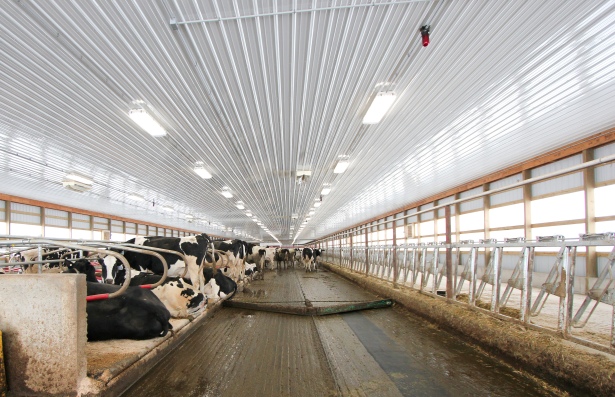“Lameness is a huge animal welfare problem — globally — across all dairy systems,” says Dr. Nigel Cook, University of Wisconsin-Madison during a dairy seminar in Pennsylvania.
The good news, he adds, is that “progress is being made. It is important that we understand how others are looking at what we do and to prioritize what is reasonable… Meeting the public partway has benefits.”
According to Cook, the average worldwide lameness percentage is 22 to 23% across all dairy housing systems. “But there is an enormous range among farms from 8% to 55%.”
 Under the FARM (Farmers Assuring Responsible Management) program, not only are farms evaluated for the percentage of severe lameness in the herd, but also abrasions and swelling. Cook notes that globally, hock lesions, which are related to lameness, run about 53% across housing systems. Under FARM, they are limited to 5 to 10% of the herd.
Under the FARM (Farmers Assuring Responsible Management) program, not only are farms evaluated for the percentage of severe lameness in the herd, but also abrasions and swelling. Cook notes that globally, hock lesions, which are related to lameness, run about 53% across housing systems. Under FARM, they are limited to 5 to 10% of the herd.
From statistical analysis of DHIA records, Cook showed that high production confinement herds had 13% lameness, which “rivals the best grazing herds that are producing half as much milk.”
Rates of lameness were also similar between conventional milking and robot environments, and the prevalence of lameness was similar for freestall environments as for tie stalls. He notes that with intervals of outdoor access, tie stalls are perfectly acceptable and offer the benefits of a controlled thermal environment, dedicated space for each cow to rest without competition as well as plenty of bunk space and personalized rations.
The key point? Any dairy housing system has its benefits, and any dairy housing system can improve its lameness percentage. Cook gave some advice.

Tie stall environments:
- Letting cows out for just one and a half to two hours a day has a very positive effect on lameness, claw health and hock lesions, which are key concerns.
- Providing higher head rails, longer neck chains and more space behind the rail are simple ways to add space in tie stalls for greater comfort, fewer injuries, less lameness and increased frequency and duration of lying bouts.
- Avoid obstructions within 24 inches of the floor of the water bowls, Cook notes.
- Provide more space via wider stalls and longer platforms. Cook says new tie stall barns in Canada are being built this way. But with more space comes a trade-off between comfort and hygiene. Providing more space leads to fewer injuries, and adjusting the location of the cow trainers helps keep manure out of the backs of the larger stalls.

Freestall environments:
- Limit the time cows spend on concrete.
- Address standing surfaces. For example, slatted floor barns have drawbacks depending on the width of the slats and the sharpness.
- Divide feed and watering areas to reduce competition and injury.

- Focus on how manure is managed. Example: Run automatic scrapers at low traffic times.
- Place foot baths for use 4x/week.
- Provide regular hoof trimming and prompt treatment of hoof issues.

- Strategic use of rubber flooring makes sense where it matters most, like in the milking center, lanes and holding areas.

- Increase lying time with fast-moving air where the cows lay down.


Stall bedding:
- Consider deep-bedding stalls. Cook notes behavioral studies reveal how deep loose bedding stalls are preferred by cows and lead to longer lying bouts, so there is less getting up and down. Similar to a bedded-pack barn (below), this can be achieved in tie stalls and freestalls with various material options.

In addition to sand as the gold standard, producers are implementing deep bedding with straw-lime mixes, sawdust, manure solids, and paper-lime mixes in both freestall and tie stall environments.
“Young, fit cows get up and down easily, but older cows have more trouble,” says Cook. “Deep loose bedding provides cushion, traction and support, so the cow can follow her normal patterns of rest.”

While longer lying bouts are good, they become a problem when cows lay longer because of lameness. In these cases, cows struggle to change position in their stalls and get pressure injuries. Deep-bedding helps reduce pressure and friction.
Robotic environments
Reducing lameness percentages is even more critical in robotic systems where voluntary visits to the robot can be affected. Cook says cow flow, flooring, bedding and bunk space can contribute.
- Feedbunk headlocks can be helpful. Even though cows in robotic systems establish their own biorhythms, when fresh feed is put down, they all want to eat.
- Two options for milking. Having two robot rooms close together and designed so that cows have two options provides more flexibility for subordinate cows and yields more milk per robot.
- Use scrapers or flush systems in robot barns, instead of slatted floors, and optimize the times when the scrapers run.

Cook notes that free subscriptions are available to access housing modules as well as modules on life cycle approaches to lameness. Click here to check them out.
— By Sherry Bunting


